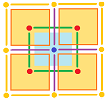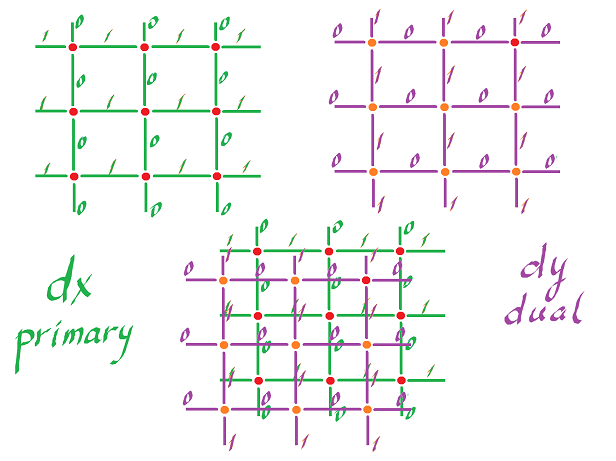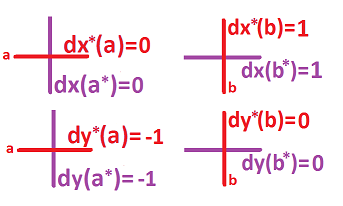This site is being phased out.
Dual cells and dual forms
Redirect to:
Duality in ${\bf R}^2$
What is the dual of a cell on the plane?
We define the dual grid "outside the box" with the same idea: the dual of a cell has the same center.
For a $2$-cell, the dual is its center:
Each $k$-cell (primary) $\alpha$ corresponds to a $(2-k)$-cell (dual) $\alpha^*$ with $\alpha^*$ centered at the center of $\alpha$.
Important observation:
Theorem. For any cell, $$\alpha^{**}=\alpha$$
Therefore for the whole plane, it's simple:
What happens if we have non-trivial cubical complex $R \subset {\bf R}^2$? Some extra work is required as the example shows:
So, in general, $$R^{**} \neq R.$$
Example: Let's verify $(dx)^* = dy$, $(dy)^*=dx$.
For either one, just turn $90^o$ and assign the same number (in the case of Euclidean geometry).
To be exact, this is how we find the values on $1$-cell for $(dx)^*$:
- vertical dual cells $1 \longleftrightarrow 1$ horizontal primary cells.
- horizontal dual cells $0 \longleftrightarrow 0$ vertical primary cells.
We find $(dx)^*$ from definition above, $(dx)^*(a) = dx(a^*)$, where $a$ is a dual cell and $a^*$ is a primary cell:
Example: This is a $1$-form $\varphi$:
Find the $1$-form $\varphi^*$:
Duality in ${\bf R}^3$
There is more going on in ${\bf R}^3$:
Note: This looks very much like the orthogonal complement in linear algebra.








